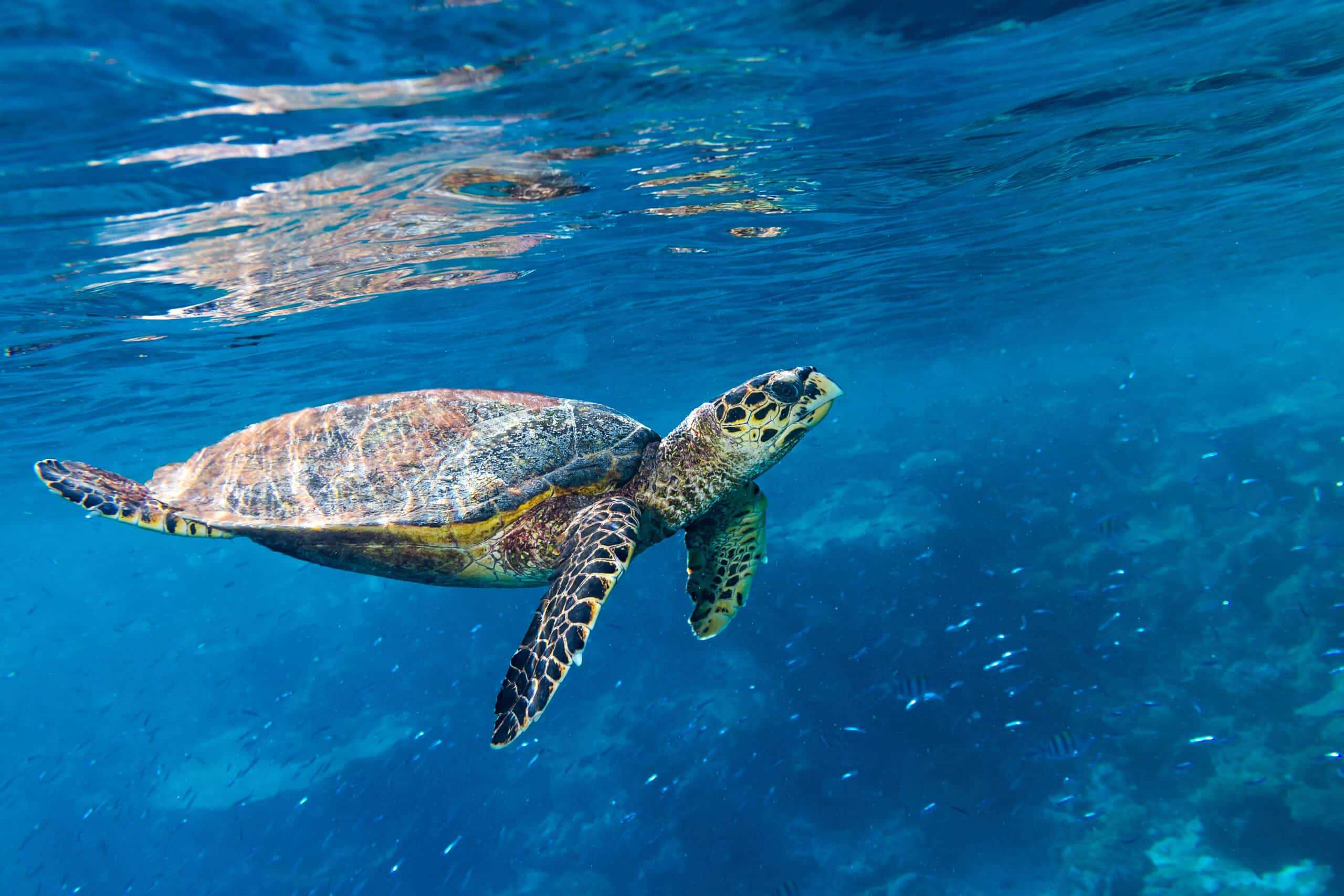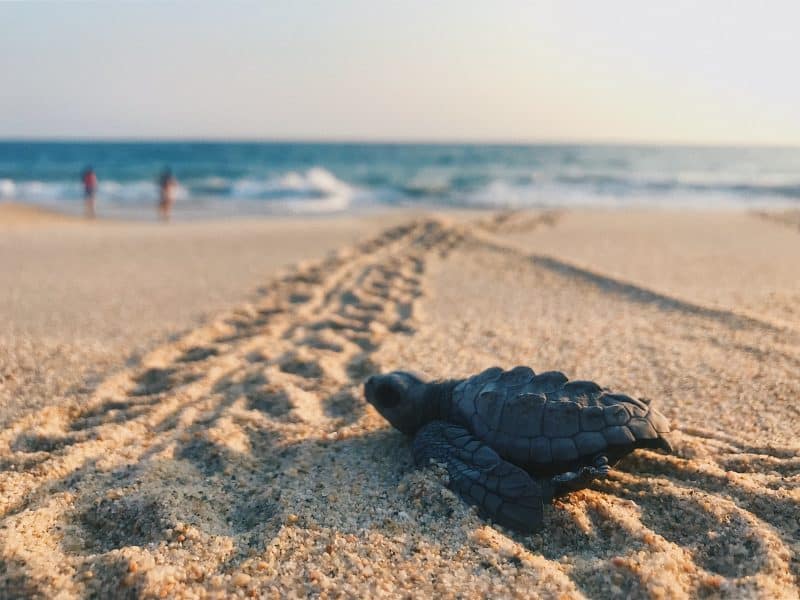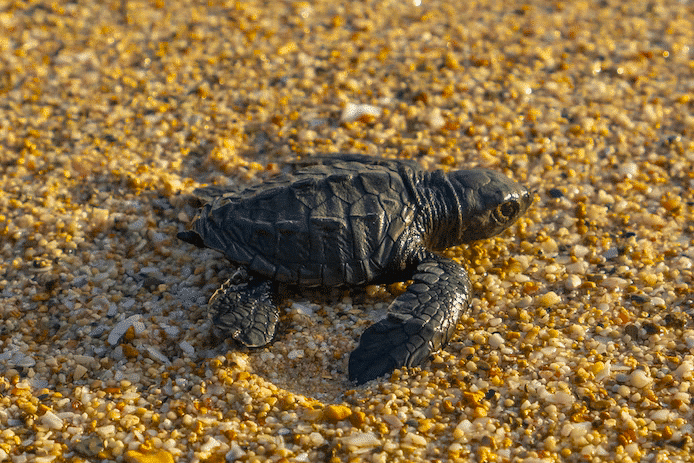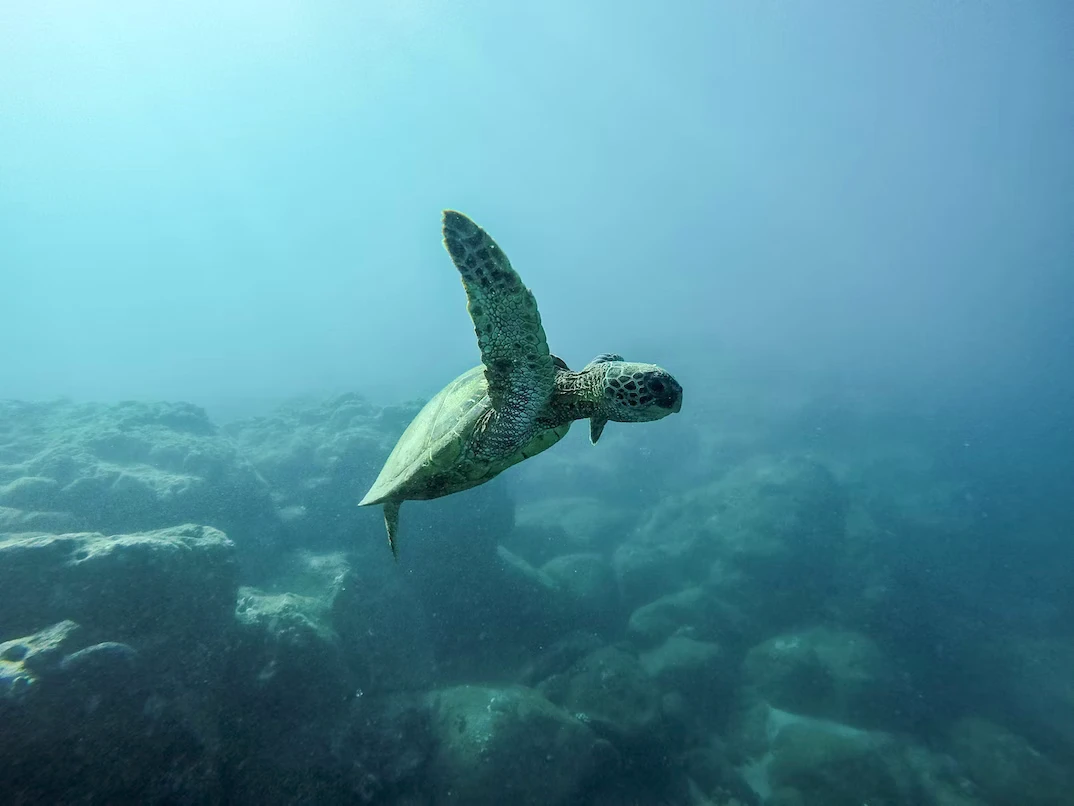Welcome to An Overview Of These Fascinating Creatures; Baby Turtles!
Ready to know these fascinating creatures?
Did you know that baby turtles are not only cute and fascinating but also essential creatures in various parts of the world? You can find these fantastic creatures in many different places across the globe!

They are born from eggs laid by their mothers and are fully grown, miniature versions of their parents. This article will examine baby turtles’ physical characteristics, habitat and distribution, diet, behavior, and conservation.
Want to jump ahead? Click below
Overview of Baby Turtles

Baby turtles are a common sight in many parts of the world and are considered one of the most important species in many ecosystems. Turtles are of various shapes, sizes, and colors and are often kept as pets.
Baby turtles are usually born from eggs laid by their mothers and can take anywhere from several months to several years to fully mature.
Importance Of Baby Turtles
Baby turtles are food sources for many animal species and help keep the balance of nature in check. Furthermore, baby turtles are also crucial to human cultures, often used as symbols of good luck, wisdom, and long life.
They are fascinating creatures essential to many ecosystems and human cultures. In the next sections, we will look closer at the physical characteristics, habitat and distribution, diet, behavior, and conservation of baby turtles.
Physical Characteristics

- Size and Shape
Baby turtles come in various sizes, with some species measuring only a few centimeters in length while others can grow to be over a meter long. Their shape is also variable, with some species having a more rounded shell while others have a more pointed or oval-shaped body.
- Shells And Scutes
It comprises a series of bony plates, known as scutes that are covered by a tough, protective layer of keratin. The shape and pattern of a turtle’s scutes are unique to each species and can help identify the turtle species.
- Coloration And Pattern
The coloration of baby turtles varies and can range from vivid greens and yellows to darker shades like browns and blacks. Some species also possess intricate markings on their shells and skin, enabling them to camouflage themselves in their environment.
- Limbs And Tail
Baby turtles use their limbs for walking and swimming. Their tails are also important, as they help to balance the turtle and are used for swimming.
Check out why do animals have tail?
- Range And Distribution
Some species, such as the red-eared slider, are widely distributed in many countries. In contrast, others, such as the leatherback sea turtle, have a more limited range and can only be found in specific regions.
Interested in The 10 Best Places to See Sea Turtles?
Threats To Turtle Habitats

There are many things that can hurt the places where baby turtles live, like when people destroy their habitats, make the water dirty, or change the weather with climate change. These things can make it hard for baby turtles to find food, places to hide, and safe spots to lay their eggs. People also catch and sell turtles as pets or fish too many of them, which can hurt their populations and where they live.
Baby turtles live in many different places and can be affected by many things people do. It’s essential to take care of these places so that baby turtles can stay healthy and safe, and so their homes stay healthy too.
- Foods And Feeding Habits
Typical foods for baby turtles include insects, worms, small fish, aquatic plants, and fruit. Baby turtles feed using their beaks to bite and tear their food.
- Foraging Strategies And Tactics
Baby turtles have different foraging strategies and tactics depending on their environment and food sources. Some species hunt for food in open water, while others forage along the shores or vegetation. Some species are active hunters, while others are more passive, waiting for food to come.
To learn more about the species of turtle with the longest lifespan – read this post.
Importance Of Proper Nutrition For Baby Turtles
The right food and nutrients are vital for their health and survival. They need a balanced diet with the right vitamins, minerals, and nutrients to grow and develop properly.
If they don’t get enough food, they can have problems like stunted growth, weaker immune systems, and other health issues. It’s essential to give them a good mix of fresh and healthy foods, clean water, and an excellent place to live, so they can stay healthy and grow up strong.
Baby turtles have diverse diets, foraging strategies, and tactics. It can include providing a variety of fresh and nutritious foods and ensuring they have access to clean water and suitable habitat.
Baby Turtle’s Behavior And Social Interactions

- Communication And Social Signals
Baby turtles communicate and interact with each other in a variety of ways. Some species speak with body language and vocalizations, while others use pheromones and scent markings. Some species are solitary animals, while others are more social and live in large groups.
- Mating And Reproduction
The mating and reproduction of baby turtles vary depending on the species. Some species mate and lay their eggs on land, while others mate and lay their eggs in the water. Some species lay their eggs in nests, while others lay in the sand or mud.
- Interactions With Other Species
Baby turtles interact with other species in various ways, including predator-prey relationships, mutualism, and competition. Some species of baby turtles are preyed upon by birds, mammals, and larger reptiles, while others form symbiotic relationships with other species, such as algae growing on their shells.
Baby turtles can make delightful and unique pets but require much care and attention to thrive. As a pet owner, it’s essential to understand baby turtles’ specific needs to provide them with a healthy and happy environment.
Baby Turtle’s Housing Characteristics
- Appropriate Enclosure Size And Type
Regarding housing, baby turtles need a spacious and secure environment miming their natural habitat. A glass terrarium or a large aquarium can serve as a suitable enclosure, but choosing a size that allows enough room for your turtle to move and swim around is essential. You should also provide a basking area where your turtle can bask in the warm light and regulate its body temperature.
- Substrate And Decorations
Choose a substrate miming the soil or sand found in its natural habitat to make your turtle’s enclosure as comfortable and natural as possible. You can also include decorations like rocks, plants, and hiding places to give your turtle a sense of security.
- Lighting And Temperature Requirements
Lighting and temperature are two important factors that affect the health and well-being of your turtle. You need a basking light that provides heat and UVB rays and a heat lamp that maintains a warm temperature in the basking area. The water temperature should be between 72-78°F, and the air temperature should be around 80-85°F.
Baby Turtle’s Diet And Feeding Habits
- Types Of Food To Offer
Baby turtles are omnivores and require a balanced diet with animal and plant-based foods. You can offer a variety of foods, including commercial turtle pellets, fresh vegetables, live insects, and small pieces of cooked meat.
- Feeding Schedule And Amounts
The frequency and amount of food you offer will depend on the size and species of your turtle. You should feed your turtle small amounts of food at least once daily and avoid overfeeding, which can lead to health problems.
Baby Turtle’s Water And Hydration Need

- Providing Fresh, Clean Water:
Baby turtles need clean, fresh water to stay hydrated, and changing the water in their enclosure at least once a week is essential.
- Maintaining Appropriate Water Quality And Temperature
The water in your turtle’s enclosure should be tested regularly for pH and chlorine levels and treated to maintain good water quality. The water temperature should be between 72-78°F, which will help your turtle regulate its body temperature and strengthen its overall health.
- Importance Of Hydration For Turtle Health
Hydration is vital for all living creatures, and turtles are no exception. A deficiency of hydration can lead to various health problems, including skin infections, shell rot, and respiratory infections.
All About Baby Turtle’s Health And Hygiene
- Monitoring For Signs Of Illness
It’s good to check your turtle’s health often to catch any possible issues immediately.
- Regular Cleaning Of The Enclosure
Keeping your turtle’s enclosure clean is essential for its health and well-being. You should clean the enclosure regularly, remove any uneaten food or waste, and replace the substrate and water as needed.
- Clean And Healthy Environment
A healthy and clean environment is essential for the health of baby turtles. Regular cleaning and monitoring help to prevent the spread of disease and maintain the overall well-being of the baby turtle.
Ways Of Handling And Interaction

- Approaches To Safe And Gentle Handling
When handling a baby turtle, it’s important to remember that they are delicate creatures that need gentle handling to avoid injury or stress. To manage your baby turtle safely, you should always support its entire body with both hands and not squeeze them too tightly. It’s also essential to avoid holding them by their tail, as this can cause injury. Instead, you should gently support their body and legs, ensuring they feel secure and comfortable.
- Importance Of Avoiding Stress For Turtles
Stress can harm a baby turtle and lead to various health problems, so minimizing stress whenever possible is crucial. Avoid sudden movements or loud noises when handling your baby turtle and give them plenty of time to rest and recover between handling sessions. It’s also a good idea to provide a warm, quiet, and dark hiding place in their habitat where they can retreat and feel safe.
- Benefits Of Regular Interaction With Turtles
While avoiding stressing your baby turtle is important, regular interaction with them can benefit their health and well-being. To help them feel more comfortable with human interaction, making it easier for you to care for and trust them. Regular interaction can also help your baby turtle feel more confident and secure, boosting their overall health and happiness.
Additional Care Considerations

- Growth And Development
As a baby turtle grows, it will need more space and a more complex habitat. You must also provide them with a balanced and nutritious diet with plant-based and protein-rich foods.
- Shedding And Molting
Baby turtles will shed their skin and shells as they grow, a natural part of their development. To help them through this process, providing a warm and humid environment and offering them various calcium-rich foods is essential. Regular monitoring of their shell and skin condition will also help you identify any problems or issues.
- Potential Health Concerns And Veterinary Care
Like all animals, baby turtles are susceptible to various health concerns, including infections, parasites, and other health problems. If you notice any changes in your baby turtle’s behavior or health, it’s essential to seek veterinary care as soon as possible. Regular check-ups with a reptile veterinarian can help catch and treat any health problems early on, ensuring your baby turtle remains healthy and happy for many years.
Conservation And Threats

- Threats To Turtle Populations
Baby turtle populations face various threats, including habitat destruction, pollution, climate change, commercial fishing, and the pet trade. These threats can impact the health and survival of baby turtles and their habitats, leading to population declines and even extinction.
- Conservation Efforts
Conservation endeavors are underway to safeguard and conserve baby turtles and their habitats. It includes safeguarding nesting sites, reducing pollution, and regulating commercial fishing and the pet trade. Conservation organizations and individuals are also working to raise awareness about the importance of protecting baby turtles and their habitats.
- The Role Of Human Activity In Turtle Decline
Human activities play a significant part in the decline of baby turtle populations. It includes habitat destruction, pollution, commercial fishing, and the pet trade. Individuals and organizations must take responsibility for their actions and work towards more sustainable practices to protect baby turtles and their habitats.
- Protecting Baby Turtle And Their Habitats
Baby turtles play a vital role in their ecosystems and are important indicators of the environment’s health. They also have cultural and economic significance, making them valuable to communities and industries. Protecting baby turtles and their habitats is essential for the health of the environment and the survival of these critical species.
Is Baby Turtle A Good Choice To Keep As A Pet?
Keeping baby turtles as pets is not recommended for several reasons. First and foremost, many species of turtles are protected by law and cannot be legally kept as pets. Even for those species that are legally owned, baby turtles can be challenging to care for properly.
They require specific diets, environments, and temperatures to thrive; without the proper setup and care, they can become sick and die.
Furthermore, many pet turtles carry Salmonella, a type of bacteria that can cause serious illness in humans, especially children and those with weakened immune systems. Practicing good hygiene and handwashing after handling turtles or cleaning their habitats is essential.
While baby turtles may seem like cute and exciting pets, they are not suitable for most people to keep. Appreciating these fascinating creatures in their natural habitats or visiting reputable zoos and aquariums is much better.
Wrapping up on Baby Turtles
Baby turtles are fascinating creatures with unique physical characteristics, habitats, and behaviors. Baby turtles are essential components of the natural world, from their diets and foraging strategies to their interactions with other species and their role in their ecosystems. By working together, we can ensure that baby turtles and their places are protected and have a great future ahead!
Join our Forum for free today!

- Surprised By A Snake In My Toilet In Bali - July 24, 2024
- Discover the Profound Spiritual Meaning of the Brown Bear - July 24, 2024
- Unexpected Snake Slithers Across My Windshield On Arizona Highway - July 23, 2024


